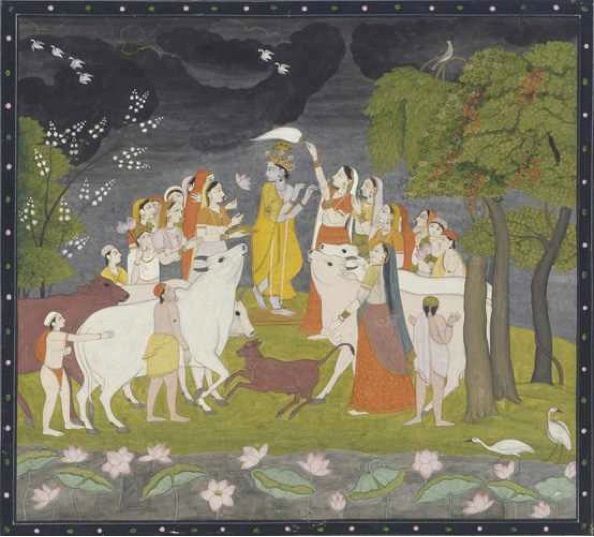
People on the spiritual path know that God loves all beings, and they know as well what would happen if all beings loved God. Spiritual practitioners also know what happens when a practitioner falls in love. However, they may not know what happens when God falls in love.
As Krishna, he falls in love with Radha, and this secret, esoteric information about the personal love life of God is the essence of krishna-bhakti—the heart of the Absolute. When God falls in love, he is in his most vulnerable moment and thus most accessible to those who tender to his inner necessity. Devotees of Krishna sing, dance, celebrate, and live this love, and Krishna is conquered by their bhakti.
Decorated with ornaments from the forest—its flowers, leaves, and multicolored clays—and crowned with the conjurer’s peacock plume, Krishna, his only weapon the flute, is God when God wants to be himself, relaxing in the company of his intimate devotees, forgetful of even his own Godhood in order to facilitate this intimacy. Krishna is the connoisseur of love, yet subjugated by his lover Radha. Radha’s love thus represents the most complete love. It is the essence of bhakti that God himself worships.
The consummation of Krishna’s love affair with Radha, in which he himself bows to her love is found in five chapters of the Bhagavata Purana’s tenth canto (29-33). Commonly known as the rasa-lila, this poem appears in the midst of the Purana’s description of the mythic lila (divine play) of Krishna, just as the flute bearing cowherd and his young love Radha reach adolescence. As the autumn moon turns full, Krishna’s love for all of the milkmaidens (gopis) of the village shines out in its maturity, and with the sound of his magical flute’s fifth note he calls the gopis and Radha in particular to meet with him in the forest bowers to dance and celebrate the secret their love.
The rasa-lila is considered by many to be the greatest story ever told. It has been recorded in the sacred literature of India, retold by poets, depicted by artists, sung about and celebrated in music, philosophized about, and meditated upon for thousands of years. It is one of the cultural and spiritual gems of the civilized world. Had it not been for the rasa-lila of Radha and Krishna, the rich religious tradition of Hinduism might have been effaced from the world during the Muslim domination of India. Although the Muslims cared little for Hinduism, they could not ignore the love story of Radha and Krishna. The Moguls in particular commissioned their artisans to depict it in art, and the Muslims were thus stopped short in their conquest by the force of mystical beauty and love. Enduring, charming, and profoundly mystical, the love story of Radha and Krishna is capable of conquering kingdoms, even one as fortified as the mythical empire of our mind. This is so because it speaks deeply to the soul, yet in a language most suited to our sensual and mental preoccupations.
There is a fine line between myth and reality. A myth can be a falsehood, or it may be the truth expressed allegorically. Indeed, at least since the time of Carl Jung it has become popular to find meaning in myth. Yet even the best myth is only an allegorical reality. It is not itself a true story.
What is the true story? For most of us, our reality is the world of our mind, informed by data gathered through our senses. This may be our reality, but how real is it? It certainly does not endure. Our instruments of perception, our senses, are imperfect to begin with, and thus the world of our mind informed by them may be more false than real. Hot, cold, happy, sad, good, and bad are mental notions relative to our sense perception. The same day is cold for one and hot for another, good for one, bad for another. We view the world though the glasses of our mental and sensual experience, yet ultimately these get in the way of truly experiencing. Vedanta tells us that which we presently perceive to be reality is more akin to myth, a falsehood, while we ourselves, the experiencers, are units of reality—souls. The phenomenal world may be real, but our perception of it is false, so false that it causes us to loose sight of our souls. The sense of the loss of our souls that dominates our culture thus serves to underscore the mythical nature of our perception of reality arising out of misdirected sensual and mental preoccupations. As for the true story, the myth that leads us to our soul leads us to reality. Indeed, that so called myth may not be a myth at all, whereas our mental and sensual perception of so called reality may be mythical. It is not altogether false, rather an allegory for the Absolute, a reflection of reality.
If we examine it closely, we will find that the reflection of reality informs us indirectly about the ultimate reality. The religious “myth” of the rasa-lila represents ultimate reality. It is an ultimate reality, however, that also confirms the value of humanity, especially its sensual and emotional aspects, for it informs us both that our sensuality has its origins in the Absolute, and that the Absolute’s expression of loving emotion is best facilitated within humanity. In the rasa-lila, God Krishna enters humanity to celebrate his sensuality, thus confirming the sense in all of us that our drive for the erotic is not something to be abolished. It is to be redirected away from the world and toward the Absolute, appearing in its human-like expression of Krishna—Radha and Krishna. In the rasa-lila we discover divine humanism, where divinity validates the essence of humanity, and humanity speaks to us about that which divinity must embody in its fullest expression.
Although the love story of Radha and Krishna has been analyzed on many levels—social, psychological, political, and so on—it implies something more profound: Our misdirected mental, sensual, and intellectual lives are a myth, while Radha and Krishna’s love drama is ultimate reality. It is the truth that many have reasoned is synonymous with beauty, and it is the eternal drama in which the soul can realize its highest potential, living in love.
Any attempt to establish a structured logical exegesis of beauty is flawed. An exegesis of ultimate spiritual beatitude is no exception. This is so because beauty, and more so the spiritual experience itself, are non-rational and transrational respectively. Spiritual beauty is not unreasonable, rather it picks up where reason leaves off. Because in this world we speak the language of logic, we must try to speak about the spiritual experience in our language. Should we broach the spiritual, however, the language of logic will be of little utility, for in the spiritual plane the language is love. While we will certainly benefit from the logical exercise of Vedanta in an effort to demonstrate that Vedanta is pointing logically to the love and beauty that Radha and Krishna personify, expressions of the experience love of itself are often more compelling. Thus if the logic falls short as it must, the poetry of and about the experience of rasa-lilaspeaks for itself. One poem expressing spiritual experience can convey the spirit of that experience more than volumes of tightly reasoned argumentation.
In our times people look for a spiritual path that is pragmatic. How will it help me in my day-to-day life? How will it make the world a better place for me to live and raise my children? These are good questions. Indeed, the world is overburdened with strife, and our individual lives are affected by it either directly or indirectly, as no decent person can live peacefully knowing of the suffering of others. Famine, disease, political oppression, corporate exploitation, and environmental disaster are but a few of the symptoms indicating the diseased condition of the world. But what is the disease itself? It is selfish desire, the disease of the heart. In the least, it is this disease that the rasa-lila seeks to address. The rasa-lila is a tale of selflessness to the extreme hidden in an exterior of apparent selfish love. That selfish love in which we are all involved and about which we are thus most eager to hear about is the context in which the ultimate in selflessness is couched. Such is the beauty and mystery of the rasa-lila, where Radha risks all, family society, and even religion, driven by her love for Krishna. While she appears to act for her own selfish interest without concern for others, in her tryst with Krishna she teaches us how to give up everything for God. If this were not the inner truth of the rasa-lila, how could her apparent selfishness cause God to fall in love with her? No story speaks more about that which we all need to hear to make the world a better place—selflessness properly centered on the perfect object of love.
1. Prasada, Dr. S.S., Bhagavata Purana: A Literary Study (New Delhi: Capital Publishing House, 1984), p. 296.
